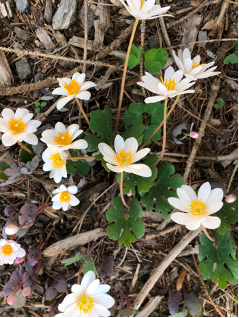Bloodroot
go.ncsu.edu/readext?838548
en Español / em Português
El inglés es el idioma de control de esta página. En la medida en que haya algún conflicto entre la traducción al inglés y la traducción, el inglés prevalece.
Al hacer clic en el enlace de traducción se activa un servicio de traducción gratuito para convertir la página al español. Al igual que con cualquier traducción por Internet, la conversión no es sensible al contexto y puede que no traduzca el texto en su significado original. NC State Extension no garantiza la exactitud del texto traducido. Por favor, tenga en cuenta que algunas aplicaciones y/o servicios pueden no funcionar como se espera cuando se traducen.
Português
Inglês é o idioma de controle desta página. Na medida que haja algum conflito entre o texto original em Inglês e a tradução, o Inglês prevalece.
Ao clicar no link de tradução, um serviço gratuito de tradução será ativado para converter a página para o Português. Como em qualquer tradução pela internet, a conversão não é sensivel ao contexto e pode não ocorrer a tradução para o significado orginal. O serviço de Extensão da Carolina do Norte (NC State Extension) não garante a exatidão do texto traduzido. Por favor, observe que algumas funções ou serviços podem não funcionar como esperado após a tradução.
English
English is the controlling language of this page. To the extent there is any conflict between the English text and the translation, English controls.
Clicking on the translation link activates a free translation service to convert the page to Spanish. As with any Internet translation, the conversion is not context-sensitive and may not translate the text to its original meaning. NC State Extension does not guarantee the accuracy of the translated text. Please note that some applications and/or services may not function as expected when translated.
Collapse ▲After the holidays come and go, we will all need something beautiful and inspiring to look forward to. Belonging to the Poppy family, Sanguinaria canadensis, otherwise known as the wildflower Bloodroot, is just the thing.
Beginning in March you will see the whitest-white in a flower petal that you have ever seen. It just draws your vision right into it. The flowers are solitary with 8-12 petals. When the flower is fully developed, it is about 1-1.5 inches across and appears to form a square shape. It only grows about 3-6 inches tall and you really have to look for it in rich, moist, shaded to partially shaded woods.
Look first for the leaves – or I should say “leaf”. Bloodroot has a single circular leaf with 5-8 lobes like the fingers of a hand.
 It’s called Bloodroot from the bright orange-red sap in the thick rootstock. While the red sap was used for dye for baskets, clothing, and paint, as well as an insect repellent it has a serious self-defense mechanism in the roots – high toxicity from Isoquinoline alkaloids, so look but don’t interfere with the roots. As a native perennial wildflower it spreads by a rhizome (underground, horizontal stem). The native variety also forms an elongated capsule (fruit) with a seed. The fruits are green pods with brown seeds that become available April-May. There is a cultivar, ‘Multiplex’, that is double-flowered and does not produce a seed. This plant makes for good seasonal groundcover.
It’s called Bloodroot from the bright orange-red sap in the thick rootstock. While the red sap was used for dye for baskets, clothing, and paint, as well as an insect repellent it has a serious self-defense mechanism in the roots – high toxicity from Isoquinoline alkaloids, so look but don’t interfere with the roots. As a native perennial wildflower it spreads by a rhizome (underground, horizontal stem). The native variety also forms an elongated capsule (fruit) with a seed. The fruits are green pods with brown seeds that become available April-May. There is a cultivar, ‘Multiplex’, that is double-flowered and does not produce a seed. This plant makes for good seasonal groundcover.
It doesn’t get seriously bothered by insects, disease, or other problems so if you have moist shade on your property it’s a great addition to the natural landscape. It’s also a great pollinator plant attracting bees and songbirds. If you don’t have woodlands on your own property, we are fortunate to have this beautiful flower on the Thoreau Trail at San-Lee Park.
Minda Daughtry is the Horticulture Agent with North Carolina Cooperative Extension in Lee County.




